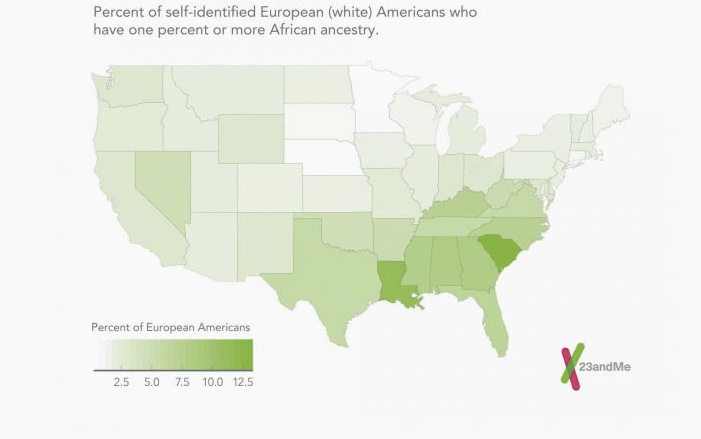Many Americans who call themselves white might be surprised to find out that they have some African ancestry. Especially in the South.
by Jenée Desmond-Harris no VOX

(23 and Me)
In a study published in The American Journal of Human Genetics in December 2014, researchers used the ancestry data compiled by the commercial genetic testing company 23and Me to measure the percentage of African ancestry of people who self-identified as white. It turns out that self-identified white people who live in the South have the highest concentrations of African DNA.
In South Carolina and Louisiana — the states shaded the darkest green on the map above — researchers found that one in 20 people who called themselves white had at least 2 percent African ancestry. And in a lot of the South, about 10 percent of people who identified as white turned out to have African DNA.
Racial mixture represents African female/European male couplings
The researchers also used genetic information to determine the genders of the specific people who were responsible for some Americans’ mixed ancestry. They found that many more (19 percent) of the ancestors of self-identified black people were European male, while only 5 percent were European females. They could even pin down the timing: the mixture generally occurred in the early 1800s, when slavery was legal. That, of course, reflects what historians know about white slave owners raping enslaved women who descended from Africa.
Where black Americans have the most African ancestry
Just like white people in the South had the most African ancestry, so did black people. The lowest percentage of African heritage in people who called themselves black was found in West Virginia. Next: Washington State.

(23 and Me)
28 percent: the tipping point for identifying as black?

(23 and Me )
Comparing ancestry data to how people self-identified, the researchers found that Americans tended to identify as European-American, rather than African-American, when they had less than 28 percent African ancestry.
h/t Quartz
WATCH: ‘220 years of population changes in one map’




